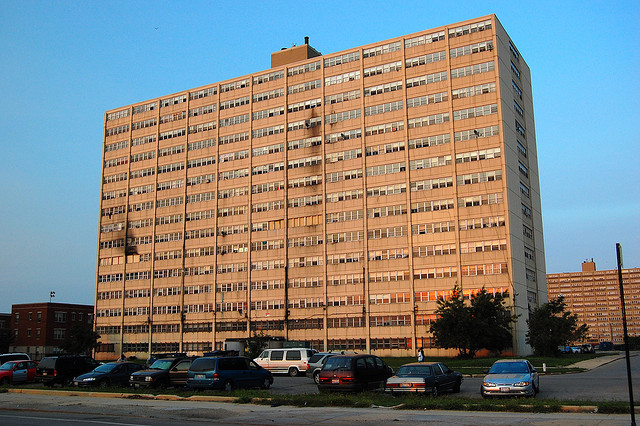
If you ask any big city mayor what is one of the most pressing problems facing his or her city, I’m guessing poverty will be high on the list. Cities across the United States are filled with pockets of hardship, and while rural poverty is widespread, too, impoverishment within metropolitan areas tends to be strikingly concentrated near downtown. Did the rich flee or the poor converge? One study says transit provides the answer.
The article begins with pages of hypotheses, formulae, and tables, but the real history of the trend is buried at the end, just before the conclusion. The key to it all is the fact that public transportation is a distinctly modern invention, and before its advent, most people lived within walking distance of their jobs, regardless of income.
It is in the late 18th and early 19th centuries that we get a geographic glimpse, uninfluenced by modern public transit, at where the rich and poor lived. Proximity to employment dictated where people lived, and people, then as now, worked everywhere. Even the most successful hedge fund’s offices are cleaned by janitors who make little more than minimum wage, and this maxim held true back in the 18th and 19th centuries as well. The difference then was that the middle-class, the well-to-do, and even some of the wealthy walked to work. Only the fabulously wealthy had hansom cabs and carriages to take them about.
When mass transit started catching on, it was mostly enjoyed by those with money, like most new technologies. Affluent types began fleeing the city for “streetcar suburbs.” But as transit prices started dropping, a new technology burst onto the scene—the automobile. For the rich, cars were far better than cramped street cars. They could travel from home to work in relative privacy (though comfort was not a given due to the poor condition of most roads in those days). Plus, cars doubled as a status symbol.
Again, the poor were stuck in the city, and many remain stuck there today. The cost of owning and operating a car is simply beyond reach for a chunk of society. And given the limited reach or slow speed of many American mass transit systems, people without cars need to live closer to their jobs, which are typically in the city.
It’s a tidy narrative, and one that the study backs up with both anecdotal snapshots,¹ statistical models, and data-driven time points from the modern day. The modern observations paint a convincing picture, and one that backs up the narrative. In cities with extensive subway systems, the study found that incomes dip slightly within a one-mile ring of downtown—where land values drop but remain accessible by transit—and then rise and hold steady from three to seven miles out. Transit usage also rises after that first mile, peaking two miles out, where incomes begin to rise. This peak exists in those cities because rail systems—they move far more quickly—appeal to more than just the poor. Wealthier people are more willing to forsake their car for a train and a simpler commute. But in newer American cities without subway systems, buses rule. In those places, most people with sufficient means pay for the shorter commute by car.² The final piece of evidence lies in the geographic distribution of jobs. In “old” American cities with extensive transit, 55 percent of the jobs in the metro area are within five miles of downtown. In “new” cities, 81 percent of jobs are more than five miles out.
The evidence in this paper led me to a few conclusions of my own. First, since the poor are less likely to use roads and highways, government highway subsidies are regressive, that economic term that describes a policy that benefits the rich more than the poor. That makes transit subsidies progressive, but even that is an oversimplification. Transit gives the poor greater access to employment, which will hopefully make them not poor in the future. It also boosts property values in the near vicinity. Since the better-off can afford pricier houses, they clearly benefit, too. Still, some communities fail to understand transit’s merits, instead equating it with an influx of poverty. These rich communities³ will eventually need more viable transit options, though, because they employ poorer people to do the things they’d prefer not to do. And as gas prices rise, no one will want to pay through the nose for that privilege.
- “…in New York, 52 percent of workers earning less than $10 per week walked to work in 1907. Only 12 percent of workers earning $20 per day used that form of transportation, and instead used streetcars. Just as the car today favored the non-poor, the streetcar did in the past, and it helps to explain why the poor lived close to the city center 100 years ago.”↩
- This in turn gives the non-poor in those cities a negative opinion of transit. As in, “Only the poor take the bus.”↩
- Parts of Orange County, I’m looking at you.↩
Source:
Glaeser, E., Kahn, M., & Rappaport, J. (2008). Why do the poor live in cities The role of public transportation Journal of Urban Economics, 63 (1), 1-24 DOI: 10.1016/j.jue.2006.12.004
Photo by reallyboring.
Related posts:
Paying for proximity: The value of houses near train stations
Do people follow trains, or do trains follow people? London’s Underground solves a riddle